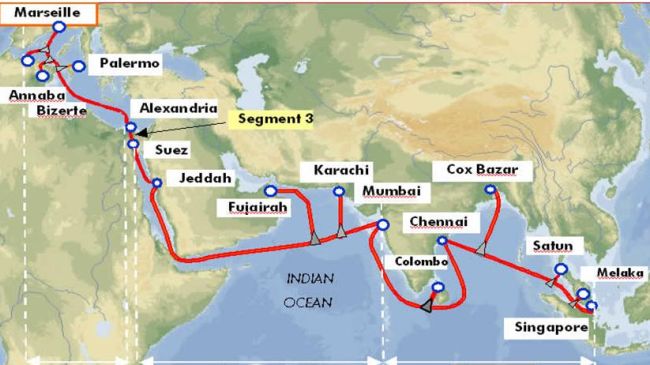
Citing classified documents labeled "top secret" and "not for foreigners", German news magazine Der Spiegel reported on Sunday that NSA spied on the so-called the South East Asia-Middle East-West Europe 4 also known as "Sea-Me-We 4 undersea cable system".
The German magazine said NSA specialists had hacked an internal website belonging to the operator consortium to mine documents about technical infrastructure including circuit mapping and network management information. "More operations are planned in the future to collect more information about this and other cable systems." Spiegel quoted the NSA documents, dating from February, as saying.
According to the website of the project "the South East Asia-Middle East-West Europe 4 project is a next generation submarine cable system linking South East Asia to Europe via the Indian Sub-Continent and Middle East. The project aims to take these regions to the forefront of global communication by significantly increasing the bandwidth and global connectivity of users along its route between Singapore and France."
Spiegel reports that "Among the companies that hold ownership stakes in it are France Telecom, now known as Orange and still partly government-owned, and Telecom Italia Sparkle."
In March 2004, a consortium of 16 international telecommunications companies signed construction and maintenance agreements for the new optical fiber submarine cable system linking South East Asia to Europe via the Indian Sub-Continent and Middle East with Terminal Stations in Singapore, Malaysia, Thailand, Bangladesh, India, Sri Lanka, Pakistan, United Arab Emirates, Saudi Arabia, Egypt, Italy, Tunisia, Algeria and France. The contract is being awarded jointly to Alcatel Submarine Networks, France and Fujitsu Ltd., Japan and the estimated project cost is of the order of $500 million.
The submarine cable system is approximately 20,000km long. It consists of the main backbone across the Eastern and Western worlds plus the extension links in various countries. The project seeks to support telephone, internet, multimedia and various broadband data applications.
It seems the method was employed by the NSA's elite hacking unit (TAO) via incorporating routers and servers from non-NSA networks into its covert network by infecting these networks with "implants" that then allow the government hackers to control the computers remotely.
The document leaked by Der Spiegel proudly says that, on Feb. 13, 2013, TAO "successfully collected network management information for the SEA-Me-We Undersea Cable Systems (SMW-4)." With the help of a "website masquerade operation," the agency managed to "gain access to the consortium's management website and collected Layer 2 network information that shows the circuit mapping for significant portions of the network."
The US government claims that its spying operations that are taking place both at home and abroad are vital for fighting terrorism.
A federal judge ruled Friday that the NSA's bulk collection of millions of Americans' telephone and Internet records is legal. US District Judge William Pauley also concluded that the operation is an important part of America's effort to combat the threat of terrorism.
NSA spies on millions of telephone and Internet records that are routed through American networks on daily basis. According to some estimates, NSA spies on 380 million cellphones in the US.
Prior to Pauley's ruling, another US District Court Judge, Richard Leon, had described the massive NSA spying program "Almost Orwellian".
"I cannot imagine a more 'indiscriminate' and 'arbitrary invasion' than this systematic and high-tech collection and retention of personal data on virtually every single citizen," Judge Leon wrote.



Reader Comments
nation is fed nothing but lies and deception, it is imperative that those in charge keep a death grip on information and truth. For Truth is the ultimate enemy of the Thugs in Charge, and they will go to any length to keep it under wraps.
And yes Honda, we all have a file. I enjoy alternative media sites, analyzing conspiracy theories, planetary history, tall brunettes, sausage onion pizza, and long walks on a beach.